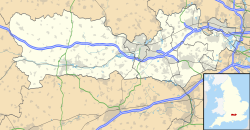| Site of Special Scientific Interest | |
 Crookham Common | |
| Location | Berkshire |
|---|---|
| Grid reference | SU 501 644 [1] |
| Coordinates | 51°22′34″N1°16′55″W / 51.376°N 1.282°W |
| Interest | Biological |
| Area | 280.5 hectares (693 acres) [1] |
| Notification | 1994 [1] |
| Location map | Magic Map |
Greenham and Crookham Commons are two adjoining public park areas of 280.5-hectare (693-acre) common land designated as a biological Site of Special Scientific Interest (SSSI) in the civil parishes of Greenham and Thatcham, on the southern outskirts of Newbury in the English county of Berkshire.
